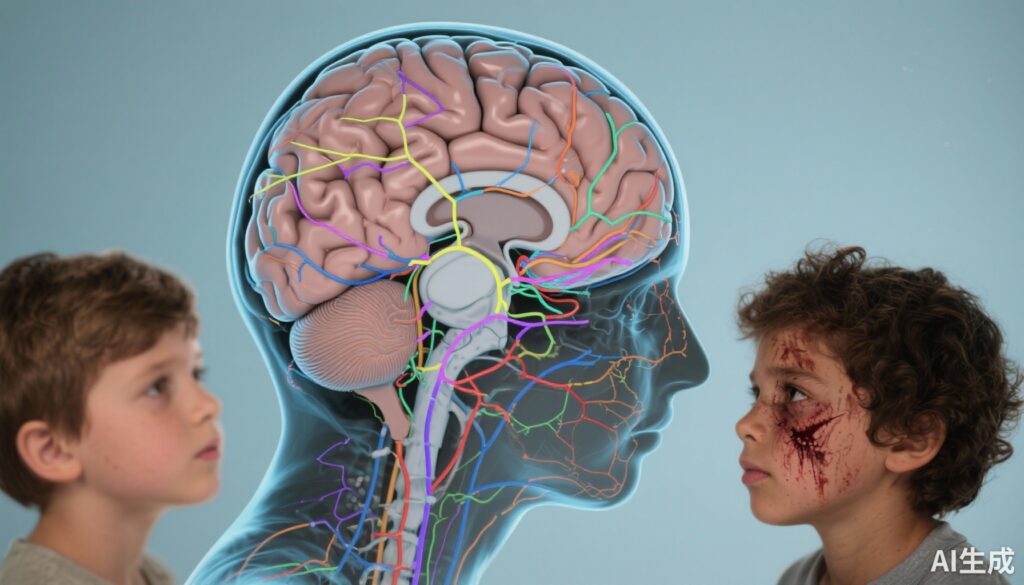Highlight
Adverse childhood experiences (ACEs) contribute to over 25% of youth psychiatric disorders, yet neurobiological pathways remain elusive. This large-scale longitudinal study from the ABCD cohort demonstrates that whole-brain functional connectivity modulates the association between ACEs and transdiagnostic mental disorders during the critical transition to adolescence. Notably, this protective effect is specifically pronounced for threat-related ACEs and among female youths, implicating cognitive control networks as key resilience substrates.
Study Background and Disease Burden
Adverse childhood experiences—including various forms of abuse, neglect, and household dysfunction—are prevalent and correlate strongly with heightened risk of developing mental disorders across the lifespan. More than a quarter of psychiatric illnesses in youth are attributable to ACEs. Despite this epidemiological burden, the neurobiological mechanisms underlying differential risk and resilience among exposed children remain poorly characterized, limiting targeted preventive strategies. Understanding how variations in brain functional architecture modify mental health outcomes after ACE exposure could inform early biomarkers of vulnerability and resilience.
Study Design
This study utilized data from the Adolescent Brain Cognitive Development (ABCD) Study, a longitudinal cohort comprising 6813 children aged 9 to 11 at baseline, recruited from 21 US sites between June 2016 and October 2018. ACE exposure was assessed via combined child and parent reports, capturing lifetime adversity through the 2-year follow-up period. Psychiatric diagnoses were derived from the computerized self-administered Kiddie Schedule for Affective Disorders and Schizophrenia for DSM-5 (KSADS-5), yielding the cumulative number of current psychiatric disorders. Baseline resting-state functional magnetic resonance imaging (fMRI) data were analyzed using machine learning to generate a latent connectome variate (CV) score, representing whole-brain functional connectivity patterns pertinent to cognitive control networks. Statistical analyses modeled associations between ACE scores, connectome connectivity strength, and psychiatric diagnosis burden at baseline and longitudinally over 2 years, adjusting for relevant confounders.
Key Findings
The cohort had a mean baseline ACE score of 2.3 (SD 1.7), with the mean age of 10.0 years (SD 0.6) and balanced sex distribution. Higher ACE scores were robustly associated with increased cumulative psychiatric disorders at both baseline (β = 0.11, 95% CI 0.10-0.12, P < .001) and 2-year follow-up (β = 0.14, 95% CI 0.12-0.15, P < .001), confirming a transdiagnostic risk effect. Importantly, the baseline whole-brain CV score significantly modified this association (interaction β = -0.02, 95% CI -0.03 to -0.01, t = -3.34, P < .001), indicating that higher functional connectivity strength attenuated the relationship between ACEs and psychopathology burden over time.
Post hoc analyses revealed that the protective modification by CV was specific to threat-related ACEs—such as physical or emotional abuse and exposure to violence—with a stronger negative interaction effect (β = -0.04, 95% CI -0.06 to -0.02, t = -3.67, P < .001). This effect was more pronounced in girls (β = -0.06, 95% CI -0.09 to -0.02, t = -3.33, P < .001), suggesting sex-specific neurobiological resilience mechanisms.
These findings imply that robust functional connectivity across distributed brain systems implicated in cognitive control and executive function may buffer the deleterious impact of ACEs, particularly threat exposures, on mental health trajectories during preadolescence.
Expert Commentary
This study addresses a critical gap in developmental psychiatry by linking neuroimaging-derived connectome metrics with ACEs and subsequent psychopathology. The use of machine learning to extract a connectome variate provides a novel dimensional approach to characterize functional brain systems relevant to resilience. Prior work has implicated prefrontal and frontoparietal circuits in top-down regulation and stress buffering; here, these functional networks appear to moderate risk in a large, diverse sample.
Moreover, the sex-specific findings accord with emerging literature on sex differences in neurodevelopmental vulnerability and resilience, underscoring the need to tailor interventions. Nonetheless, the observational nature limits causal inference, and residual confounding cannot be excluded. Future research should explore the longitudinal evolution of functional connectivity in relation to targeted psychosocial or neurobiological interventions. Integration with genetic and environmental data could further delineate resilience pathways.
Conclusions
In sum, this large longitudinal cohort study demonstrates that whole-brain functional connectivity modifies the association between ACEs and development of psychiatric disorders in preadolescents, with an amplified protective effect for threat-related adversities and female children. These findings support the potential of functional connectivity biomarkers to identify youths at differential risk and resilience following early life adversity, informing precision prevention strategies. Enhancing cognitive control system connectivity may represent a promising target for early intervention to mitigate the psychiatric sequelae of childhood trauma.
References
Xiao X, Hammond CJ, Salmeron BJ, Wang D, Gu H, Zhai T, Murray L, Quam A, Hill J, Nguyen H, Lu H, Hoffman EA, Janes AC, Ross TJ, Yang Y. Modification of Brain Connectome on Association Between Adverse Childhood Experiences and Development of Mental Disorders in Preadolescence. JAMA Netw Open. 2025 Sep 2;8(9):e2533136. doi: 10.1001/jamanetworkopen.2025.33136. PMID: 40982276.
Felitti VJ, Anda RF, Nordenberg D, et al. Relationship of Childhood Abuse and Household Dysfunction to Many of the Leading Causes of Death in Adults: The Adverse Childhood Experiences (ACE) Study. Am J Prev Med. 1998 May;14(4):245-58.
McLaughlin KA, Sheridan MA. Beyond cumulative risk: a dimensional approach to childhood adversity. Curr Dir Psychol Sci. 2016;25(4):239-245.
Sipahi R, Sassi RB, Tai P, et al. Neural correlates of resilience: a meta-analysis of functional MRI studies. Front Psychol. 2020;11:563206.
Rutter M. Resilience and Development: Contributions from the Study of Children Who Overcome Adversity. Dev Psychopathol. 2006;2(4):425-444.



